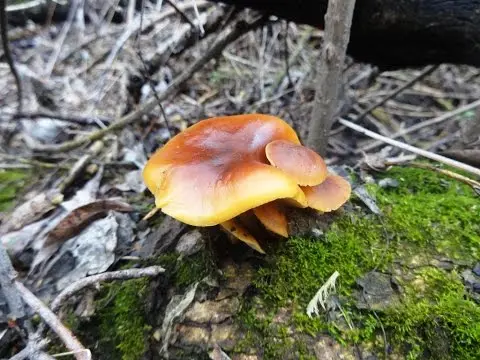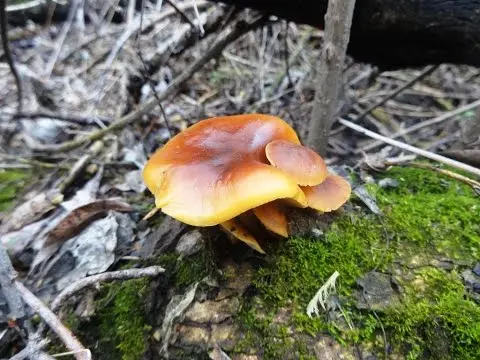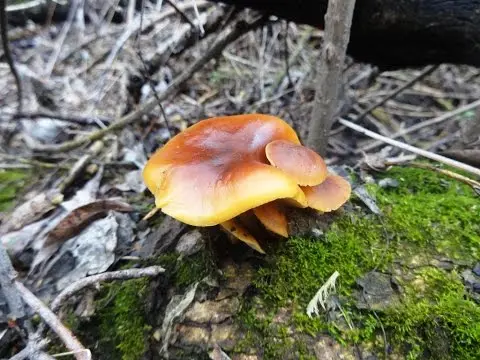Contents
- Winter edible mushrooms: a description of what mushrooms look like in the forest (with photo)
- Winter variety of mushrooms: photos and how to distinguish edible mushrooms from false ones
- Winter mushroom season: where and when mushrooms grow
- When do winter mushrooms appear and how to find them in the forest
- How fast do winter mushrooms grow and when can they be harvested
It is generally accepted that winter is not the time for the mushroom season. Indeed, few people can be found in the forest during such a cold period. However, for experienced mushroom pickers, winter is not a reason to warm up at home by the stove. It is with the onset of cold weather that it becomes possible to go on a “hunt” for winter mushrooms. It turns out that mushroom harvesting at this time of the year is not without meaning. It is in the winter forest that bright fruit bodies grow abundantly, which will be discussed. For clarity, on this page you can find a description, photo and video of winter mushrooms.
Winter mushrooms (flammulina velutipes) – cap mushrooms belonging to the Ryadovkovye family. These fruiting bodies are very much appreciated among many mushroom pickers, because they have a pleasant and delicate taste, therefore they are widely used in cooking. They are perfect for processes such as marinating and salting. Various soups and sauces are also prepared from them. However, some prefer not to deal with winter mushrooms, as they become slimy during cooking, although this feature does not affect the taste of the dish.
Another name for winter honey agaric is velvety-legged flammulina. It indicates a characteristic feature of the appearance of a given fruiting body. As for edibility, it belongs to category 4. This means that the mushroom needs mandatory heat treatment.
Below you can see a more detailed description of winter mushrooms and photos that clearly show the characteristic features of their appearance.
[ »wp-content/plugins/include-me/ya1-h2.php»]
Winter edible mushrooms: a description of what mushrooms look like in the forest (with photo)
[ »»]
Latin name: Flammulina velutipes.
Sort by: Flammulina.
Family: Ordinary, also belong to the Negnyuchkovye family.
Synonyms: Agaricus velutipes, Collybia velutipes, Collybidium velutipes, Gymnopus velutipes, Myxocollybia velutipes.
synonyms: velvety-legged flammulina, velvety-legged collibia, winter mushroom. In the West, they are most often found under the Japanese name “enokitake”.
Hat: rounded-convex, with age acquires a flat shape. The diameter is from 2 to 8 cm, however, some large specimens can reach 10 and even 12 cm. The color of the cap varies from yellow or honey to orange-brown. In most cases, the edges of the cap have a lighter shade than the central zone. Mucous, smooth, with a slight drying takes on a glossy appearance. Pay attention to the hats of winter edible mushrooms by looking at the photo.
Leg: cylindrical, tubular, dense, velvety, 3-8 cm high, up to 1 cm thick. The upper part has a lighter shade (yellow), and the lower part is darker (brown or red).
Pulp: thin, stiff at the lower edge of the stem and softer at the cap. White or light yellow, with a slightly pronounced pleasant smell and taste.
Records: sparse, slightly adhering to the stem, sometimes shortened. The color of the plates in young individuals ranges from cream to yellowish-white, darkening with age.
We offer you to see a few more photos of winter honey agaric in the forest:
As you can see, they have a brighter color than representatives of other types of edible mushrooms. Knowing what winter mushrooms look like in the photo, it will be much easier for you to find them in the forest.
Edibility: conditionally edible, belongs to category 4.
Winter variety of mushrooms: photos and how to distinguish edible mushrooms from false ones
Application: used in cooking and medicine. They are pickled, salted, fried, caviar, soups and sauces are made from them. In young specimens, only the lower part of the leg is removed; in mature specimens, only hats are taken. Mushrooms are very popular in Japanese cuisine. In medicine, it is used for the treatment and prevention of benign tumors – fibromas, myomas, adenomas, mastopathy and other types of oncology. Used for thrombophlebitis and increased blood clotting.
Similarities and differences: the winter variety of honey mushrooms does not have false poisonous twins. Nevertheless, their appearance can be confused with summer honey agarics and spindle-legged collybia. However, they are almost impossible to meet next to the winter honey agaric. The fact is that the time of their fruiting completely diverges from the season of flammulina activity. But be that as it may, it is necessary to know some differences between them.


As you can see in the photo, you can distinguish winter mushrooms from false ones by the presence of a ring on the leg: in edible species it is clearly visible, while in false species it is completely absent.


Collybia fusipoda – a fruiting body of dubious nutritional quality. The cap of the mushroom has a pronounced red-brown color. The leg is often twisted, noticeably narrows downwards, has a red-red tint. Comparing photos and descriptions of winter mushrooms with false species, you can easily determine where and which fruiting bodies.
Spread: winter honey agaric grows in the northern temperate zone, being a parasitic fungus. Prefers stumps, fallen trees, live and damaged trunks. Most often, flammulina can be found on deciduous trees: willow, poplar, aspen, elm, maple, etc. It grows much less frequently on conifers, sometimes choosing dead wood.
[ »]
Winter mushroom season: where and when mushrooms grow
Many novice mushroom pickers are interested in when winter mushrooms grow? Judging by the name, we can conclude that the winter mushroom season starts with the onset of cold weather. As already noted, this type of fruiting bodies grows most often in deciduous forests, but sometimes they can be found in city gardens and parks, near roads and industrial enterprises.


Flammulina grows in large families, like most other types of mushrooms, forming honey-golden “bouquets”. Due to their bright color, winter mushrooms are often grown as a decorative ornament for home gardens. However, it should be remembered that these fungi destroy wood, leading it to dry out and death.
Depending on where winter mushrooms grow, you can tell what taste and smell they have. So, growing on deciduous trees, the pulp of the fungus will have a more delicate taste and aroma. And settling on a pine or spruce, the fruiting body acquires a characteristic smell and a bitter, resinous aftertaste.
When do winter mushrooms appear and how to find them in the forest
[ »wp-content/plugins/include-me/goog-left.php»]
The period when winter mushrooms appear depends on the climatic features of individual territories. Traditionally, the first harvest appears in late September – early October. The peak of abundant fruiting falls on November-February, sometimes a large number of mushrooms can be observed in May. Thus, under certain weather conditions, winter honey agaric can be collected almost all year round.
One of the characteristic features of flammulina is that it tolerates frost very well. During the period of frost, the fungus freezes, but does not die. At the first thaw, its growth resumes, and the very structure of the fruiting body returns its flexibility and original appearance. I must say that you can find this mushroom even under a layer of snow. It can be easily collected both frozen and thawed, because even with severe frosts it will not lose its taste.
Knowing when winter mushrooms grow, and under what conditions this process occurs, many mushroom pickers do not miss the opportunity to visit the forest during the cold season. They may find that during frosts, the caps begin to crumble when pressed, but do not be afraid of this. In a warm room, they will thaw and return to their former elasticity.
And how can you find winter mushrooms in the forest? Fans of “silent hunting”, who have many years of experience in this matter, note that such an occupation is not an easy one. In addition to fallen trees and stumps, you need to look into hollows. Sometimes you can find a whole “army” of honey-golden “soldiers” there. In addition, when picking mushrooms, you should not only look under your feet, but also raise your eyes up. Often, winter mushrooms grow precisely at a height that can reach up to 3 m. In this case, you should take a long stick with a hook with you, thanks to which it will be easy to remove mushrooms from a tree.
How fast do winter mushrooms grow and when can they be harvested
Also, many novice mushroom pickers are interested in how quickly winter mushrooms grow? As you know, all mushrooms, without exception, grow very quickly. If the weather is favorable for the growth of the fruit body outside the window, then after 2-3 days you can go to the forest. Under what circumstances, then, does the growth of the winter fungus occur? In this case, everything will depend on weather conditions. In the absence of strong and prolonged frosts, the fruiting body can grow in a few days. According to studies, flammulina can increase by 1-2 cm per day. And vice versa, if frost sets in, then the growth of such mushrooms practically stops, but only until the first thaw. It is with her arrival that the mushroom continues to grow, delighting the eyes with its motley color in the “naked” forest. Therefore, in order to know when you can go to collect winter mushrooms, you need to be guided by the weather, because the growth of fruiting bodies depends on it.
The surface of the cap of the winter honey agaric is slightly covered with mucus, which does not disappear even when boiled. In addition, it is customary to remove the stem of the fruiting body completely, as it is too rigid. There is also evidence that the pulp of the fungus may contain a small amount of toxins, so it must always be subjected to heat treatment. To do this, after cleaning, the winter mushroom is boiled in salted water for at least 20 minutes, and then they start cooking.









